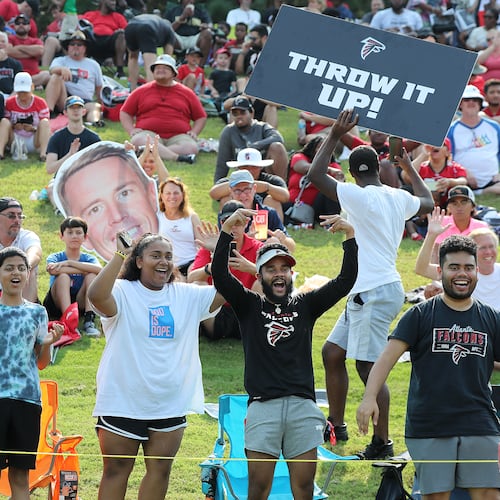The four NFL teams with retractable-roof stadiums have chosen to play almost twice as many games with the roofs closed than with them open. That lone statistic raises the question of whether the convertible tops, such as the one planned for a new Atlanta stadium to be partially funded with public dollars, are worth the increased cost over a fixed dome.
Those teams’ open-or-closed decisions contrast with the Falcons’ stated intentions for games in their proposed facility.
“We believe football was meant to be played outdoors to the extent it can be played outdoors,” Falcons president and CEO Rich McKay said recently. “And therefore we would tell you today we intend to have it open a lot.”
That stance is in keeping with Falcons owner Arthur Blank’s original preference for a roof-less, open-air stadium. But the intentions would be tested on a game-to-game basis by the tempting flexibility of a retractable roof, which the proposed stadium must have in order to also accommodate events that require an indoor facility. The stadium’s design will be key in how the Falcons ultimately use the roof, McKay said.
The cost of a retractable roof is tens of millions of dollars more than a fixed roof.
Yet, the NFL teams with retractable roofs — the Houston Texans, Arizona Cardinals, Indianapolis Colts and Dallas Cowboys — have played 66 percent of their games in their current stadiums with the roofs closed, according to figures obtained from the teams by The Atlanta Journal-Constitution. Out of 225 regular-season and playoff games in the four stadiums, 149 have been played with the roof closed and 76 with it open.
The Texans have played 31 games with the roof open and 59 with it closed; the Cardinals 19 with it open and 40 with it closed; the Colts 13 open and 30 closed; and the Cowboys 13 open and 20 closed. The stadiums range in age from 11 years (the Texans’) to four years (the Cowboys’).
The Falcons’ proposed stadium is in the hands of the Atlanta City Council, which is considering the possible use of $200 million in bonds backed by the city’s hotel-motel tax toward the estimated $1 billion facility. If the stadium is built, the roof would play a big part in the fan experience, pro or con.
The Falcons played their home games outdoors in Atlanta-Fulton County Stadium for 26 seasons (1966-91) before moving indoors at the Georgia Dome 21 years ago. A retractable roof makes indoor-outdoor a weekly decision that belongs to the home team and often stirs debate.
NFL teams with retractable roofs say weather conditions and fan comfort are the driving factors in their open-or-closed choices. The decision can be easy on days of heavy rain or extreme temperature, but controversial in some other conditions, such as days when direct sun makes certain seats uncomfortable. And non-meteorological factors also are believed to influence the decision at times, such as a team’s desire for louder crowd noise in a closed stadium or a coach’s (or quarterback’s) preference for controlled conditions.
The Texans’ policy is to “consider” opening the Reliant Stadium roof when the game-time temperature is forecast between 50 and 80 degrees with no significant threat of rain. Emphasis should be placed on “consider,” because the team often keeps the roof closed even then. In fact, the Texans played all of last season’s home games with the roof closed.
“The decision to open or close the roof each game is a very difficult one to make … because there are significant differences within the stadium depending upon where you are seated, sun or shade,” the Texans said in a lengthy letter to fans. “… We choose the (roof) position that we feel will provide the best environment for our team to play and our fans to enjoy the game.”
The Cardinals have a telephone “hotline” fans can call before leaving home on game days to find out if the roof will be open or closed. The team is more likely to open it late in the season. But despite beautiful weather outdoors on Jan. 3, 2009, the Cardinals closed the roof for a playoff victory over the Falcons, ensuring a louder environment.
Other than the common tendency to close them, the NFL’s retractable roofs vary significantly from stadium to stadium.
“Every one of those roofs is a unique design to the facility it is on,” said John Dixon, executive vice president of the sports sector for Manhattan Construction, which built the Cowboys’ and Texans’ stadiums.
The roof material, construction method, technology and size of the opening all differ. Although Cowboys Stadium is larger than Reliant Stadium or any other NFL facility, the Cowboys’ roof opening (410 feet long by 256 feet wide) is smaller than Houston’s (500 feet long by 385 feet wide). The Cowboys’ opening was made smaller, Dixon said, because team owner Jerry Jones wanted it to proportionally emulate the signature hole-in-the-roof design of the franchise’s former home, Texas Stadium.
Costs attributed to retractable roofs also vary widely, depending on the design and whether added construction costs to support the weight are included in the quoted price.
A study last year by architect Populous estimated the cost of a retractable roof on the proposed Falcons stadium at $183 million. The study did not estimate the price of a fixed roof because that design is not being considered. However, the Minnesota Vikings are considering both options for their new stadium, and the retractable roof is estimated to cost about $40 million more than the fixed.
When negotiations about a new Atlanta stadium began two years ago, the Falcons did not want a roof at all because of the cost. They wanted an open-air stadium about a half-mile from the Georgia Dome, which would have continued to operate for events that required an indoor facility, such as the SEC Championship game and college basketball’s Final Four.
But the GWCCA and the Falcons could not reach a financial agreement on a two-stadium approach and shifted the plan to a retractable-roof stadium that would replace the Dome for all events.
McKay said the Falcons conducted a 10-year Atlanta weather study and found it “incredible how few times it rained on game day.” Still, McKay said the proposed stadium’s design — yet to be done — would influence how other weather conditions affect the fan experience and roof usage.
“The design becomes critical in the way the sun and wind affect fans inside the bowl,” he said. “You’ve got to make sure all of those elements are taken into account.”
About the Author
Keep Reading
The Latest
Featured


